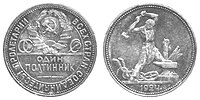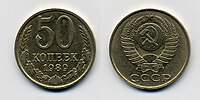Soviet ruble
The Soviet rubles , mostly short rubles called ( Russian рубль , transliteration Rubl' ) was the currency of the Soviet Union and some of its successor states between 1919 and 1993. The kopek ( копейка / Kopeyka) is the hundredth part of the ruble.
In addition to the banknotes and coins used in the Soviet Union, there was also the transfer ruble for offsetting deliveries within the Comecon .
For the etymology, prehistory and current situation, see the main article Ruble .
Designations in the Soviet Union
As a multi-ethnic state , the Soviet Union had a large number of official languages . Therefore, the banknotes carried the currency denomination and the face value in all these languages. The following table shows the names in the languages of the individual Soviet republics in the order in which they were listed on the banknotes:
| language | in local language | |
|---|---|---|
| ruble | Kopeck | |
| Russian | рубль | копейка |
| Ukrainian | карбованець | копійка |
| Belarusian | рубель | капейка |
| Uzbek | сўм | тийин |
| Kazakh | сом | тиын |
| Georgian | მანეთი | კაპიკი |
| Azerbaijani | манат | гəпик |
| Lithuanian | rublis | kapeika |
| Moldovan | рублэ | копейкэ |
| Latvian | rublis | kapeika |
| Kyrgyz | сом | тыйн |
| Tajik | сўм | тин |
| Armenian | ռուբլի | կոպեկ |
| Turkmen | манат | көпүк |
| Estonian | rubla | kopikas |
Note: Since the collapse of the Soviet Union, Uzbek, Azerbaijani, Moldavian and Turkmen are no longer used in the Cyrillic alphabet , but in the Latin alphabet .
history
The first Soviet ruble
After the October Revolution of 1917, the existing Tsarist rubles initially remained in circulation. During the Russian Civil War , both the whites and the Bolsheviks issued their own banknotes. The banknotes issued by the communist side from 1919 were provisional issues based on the tsarist rubles. They were officially valid in the Russian Federal Socialist Soviet Republic , but in fact only in the areas that were under the rule of the Bolsheviks during the civil war.
The volume of banknotes printed led to hyperinflation . The banknotes were issued in the following nominal amounts: 1, 2, 3, 5, 10, 15, 25, 50, 60, 100, 250, 500, 1000, 5000, 10,000, 25,000, 50,000, 100,000. In addition, short-term state promissory notes were issued in denominations of 1, 5 and 10 million rubles, which served as banknote substitutes.
The inflation money was made in different print patterns. As with the German inflation money, the printing was done with a few security features . Sometimes the notes were only printed on one side.
| year | Cash in circulation (billion rubles) |
Price index 1913 = 100 |
|---|---|---|
| 1915 | 3,030 | |
| 1916 | 5,622 | |
| 1917 | 9.097 | |
| 1918 | 27,312 | |
| 1919 | 61,265 | |
| 1920 | 225.016 | 2,100 |
| 1921 | 1,168,600 | 16,400 |
| 1922 | 17,539,000 | 242,000 |
| 1923 July 1st | 340,150,000 | 1,680,000 |
In the context of war communism , according to the party program of the CPSU, money should be completely abolished and the Russian economy should be converted into a distribution economy in the medium term. As a first step in 1917 all banks were directly subordinated to the central bank (the People's Bank of the RSFSR; Narodnyi bank RSFSA) and by decree of January 28, 1920 all banks including the central bank were abolished. The only issuer of the money was the state itself.
Second Soviet ruble, January 1, 1922–31. December 1922
The financial crisis could only be remedied with the reopening of the State Bank on November 16, 1921. The decree of June 30, 1921 again allowed private ownership of money without restrictions. With the Chervonetz , a new (parallel) currency with (officially) 25 percent gold cover was introduced. The "new" ruble was exchanged for the old ruble at a ratio of 1 to 10,000. Until the Sowsnaki were withdrawn from circulation in February 1924, they had a double currency. Despite the official commitment to partial gold backing, extensive printing of new notes continued, combined with the corresponding inflation.
Third Soviet ruble, January 1, 1923–6. March 1924
Strictly speaking, this edition was the first of the Soviet Union founded in 1922. Another currency reform took place . The existing rubles were devalued at a ratio of 1 to 100.
Fourth (gold) Soviet ruble, March 7, 1924–1947
A third currency reform in 1924 introduced the “gold” ruble with a value of 50,000 of the previous ruble. With this reform, the ruble was pegged to the Chervonetz. Coins were minted in rubles. Bills were issued for the smaller denominations of up to 10 rubles in rubles and above in Chervonets.
Fifth Soviet ruble, 1947–1961
After the Second World War , the Soviet government made a confiscatory currency cut in order to drastically reduce the currency in circulation. This currency cut only affected the banknotes. The currency cut was made in the ratio of ten old to one new ruble.
Sixth Soviet ruble, 1961–1991
In 1961, a currency cut was made again based on the model of the 1947 measure. Here, too, the cut was 1:10. The new banknotes were created by the artist Victor Tsigal with propaganda depictions of Soviet life and Soviet industry. Formally, this 1961 ruble was equivalent to 0.987412 grams of gold . However, due to the strict ban on gold , i.e. the ban on trading gold for the population, this did not play a role in practice. Officially, the government set an exchange rate of 1 to 1 for the pound sterling . This official course remained unchanged until the end of the Soviet Union. Since the ruble was not freely convertible , this rate only played a role for compulsory exchange and under criminal law. In trade within the Eastern Bloc , the transfer ruble was used as a unit of account, in trade with non-socialist countries it was settled in western currency. This ruble remained in use until the collapse of the Soviet Union and was replaced by the currencies of the successor states.
| Series 1961 | |||||
|---|---|---|---|---|---|
| image | value | ||||
| front | back | ||||

|

|
1 ruble | |||

|

|
3 rubles | |||

|

|
5 rubles | |||

|

|
10 rubles | |||

|

|
25 rubles | |||

|

|
50 rubles | |||

|

|
100 rubles | |||
| Series 1991 | |||||
|---|---|---|---|---|---|
| image | value | ||||
| front | back | ||||

|

|
1 ruble | |||

|

|
3 rubles | |||

|

|
5 rubles | |||
|
|
|
10 rubles | |||
|
|
|
50 rubles | |||
|
|
|
100 rubles | |||
|
|
|
200 rubles | |||
|
|
|
500 rubles | |||
|
|
|
1000 rubles | |||
Economical meaning
In the planned economy of the Soviet Union, the government set commodity prices and exchange rates. This always resulted in excess money, only some of the products could be purchased in the desired quantities for rubles ( shortage economy ). A large number of products were only available against coupons , on the black market or through relationships. The role of money was therefore different from that in market economies . The ruble was not convertible and was not allowed to be exported.
Successor currencies
With the collapse of the Soviet Union in 1991, the independent states created their own currencies. The Bank Rossii (Russia's Central Bank) took over the Gosbank (the Soviet Central Bank) and also supplied those States that continued to use the ruble, with money.
In the months that followed, more and more countries left the ruble zone.
| country | New currency |
Exchange rate against the ruble |
Date of introduction of the new currency | Date of leaving the ruble zone | Remarks |
|---|---|---|---|---|---|
|
|
Dram | 200 | November 22, 1993 | ? | - |
|
|
Manat | 10 | 15th August 1992 | ? | The manat was devalued on January 1, 2006 at a ratio of 5,000 to 1 |
|
|
ruble | 10 | May 1992 | ? | The Belarusian ruble was devalued at a ratio of 1,000 to 1 on January 1, 2000. |
|
|
Crown | 10 | June 20, 1992 | June 22, 1992 | Bound to the German Mark (1 DEM = 8EEK). The first hard currency on the territory of the former Soviet Union. Estonia introduced the euro in early 2011. |
|
|
lari | 1 | April 5, 1993 | ? | The "first Lari" was introduced as an interim solution and replaced by the Lari on October 2, 1995 at a ratio of 1,000,000 to 1 . |
|
|
Tenge | 500 | November 15, 1993 | ? | - |
|
|
Som | 200 | May 10, 1993 | May 15, 1993 | Until January 1, 2008 only banknotes were issued. |
|
|
Rublis | 1 | May 7, 1992 | July 20, 1992 | The Latvian ruble (Rublis) was a transition currency until the introduction of the lat in March 1993. The exchange rate was 200 to 1. Latvia introduced the euro in early 2014. |
|
|
Talonas | 1 | May 1, 1992 | October 1, 1992 | The transition currency Talonas was exchanged for Litas on June 25, 1993 at a ratio of 100 to 1 . Lithuania introduced the euro on January 1, 2015. |
|
|
Cupon | 1 | 1992 | ? | The cupon was only a transitional currency that was exchanged for the leu on November 29, 1993 at the rate of 1,000 to 1 . |
|
|
Russian ruble | 1 | 1992 | July 1993 | The Russian ruble was consolidated at a ratio of 1,000 to 1 on January 1, 1998. |
| Transnistria | ruble | 1 | 1994 | ? | The Transnistrian ruble was pooled at a ratio of 1,000,000 to 1 in 2000. |
|
|
Ruble | 100 | May 10, 1995 | ? | Due to the civil war , Tajikistan was the last country to leave the ruble zone. The Tajik ruble was replaced by the somoni on October 30, 2000 at an exchange rate of 1,000 to 1 . |
|
|
Manat | 500 | November 1, 1993 | ? | Devalued at a ratio of 5,000 to 1 in 2009. |
|
|
Karbowanez | 1 | January 10, 1992 | ? | The Karbowanez was converted to the hryvnia at the rate of 100,000 to 1 on September 2, 1996 . |
|
|
So'm | 1 | November 15, 1993 | November 15, 1993 | The first So'm was a transitional currency that was converted on July 1, 1994 at an exchange rate of 1,000 to 1. |
literature
- Günter Hedtkamp: The Soviet financial system. Duncker and Humblot, Berlin 1974, ISBN 3-428-03057-5 .






